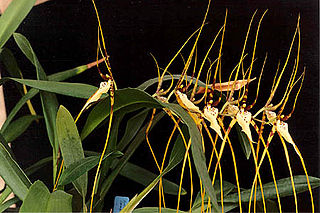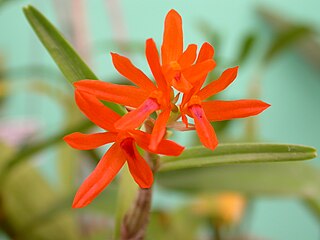
Brassia is a genus of orchids classified in the subtribe Oncidiinae. It is native to Mexico, Central America, the West Indies, and northern South America, with one species extending into Florida.

Sobralia is a genus of orchids native to Mexico, Central and South America. The plants are more commonly terrestrial, but are also found growing epiphytically, in wet forests from sea level to about 8,800 ft. The genus was named for Dr. Francisco Sobral, a Spanish botanist. The genus is abbreviated Sob in trade journals.

Specklinia is a genus of orchids native to South America, Central America, and the Caribbean. It contains approximately 100 species.

Laeliinae is a Neotropical subtribe including 40 orchid genera, such as Brassavola, Laelia and Cattleya. The genus Epidendrum is the largest within this subtribe, containing about 1500 species. This is followed by the genus Encyclia, with over 120 species.

Ponthieva is a genus in the orchid family (Orchidaceae), commonly known as the shadow witch. They are named after Henry de Ponthieu, an English merchant of Huguenot ancestry who sent West Indian plant collections to Sir Joseph Banks in 1778.

Acianthera is a genus of orchids native to the tropical parts of the Western Hemisphere, especially Brazil. It was first described in 1842 but was not widely recognized until recently. Most of the species were formerly placed under Pleurothallis subgenus Acianthera. This splitting is a result of recent DNA sequencing.

Scaphyglottis is a genus of orchids native to Mexico, Central America, northern South America and parts of the Caribbean. The current concept of this genus is the result of combining several genera which have been described at various times. The concept is characterized by the growth habit: not only are new pseudobulbs added at the base of the old ones, but new pseudobulbs also grow at the apices of the old ones. Many species are quite similar and difficult to distinguish, but some are clearly distinct. A few have showy colors. The genus comprises nearly 70 species.

Cischweinfia is a genus of flowering plants from the orchid family, Orchidaceae. It was named after Harvard orchidologist Charles Schweinfurth. It has eleven currently recognized species, all native to Central America and northwestern South America.

Fernandezia is a genus of flowering plants from the orchid family, Orchidaceae. It contains about 30-40 species, native to northern South America, Central America, and southern Mexico.

Galeottia is a genus of flowering plants from the orchid family, Orchidaceae. It is native to South America, Central America and southern Mexico.
- Galeottia acuminata(C.Schweinf.) Dressler & Christenson
- Galeottia antioquiana(Kraenzl.) Dressler & Christenson
- Galeottia burkei(Rchb.f.) Dressler & Christenson
- Galeottia ciliata(C.Morel) Dressler & Christenson
- Galeottia colombiana(Garay) Dressler & Christenson
- Galeottia fimbriata(Linden & Rchb.f.) Schltr.
- Galeottia grandifloraA.Rich.
- Galeottia jorisiana(Rolfe) Schltr.
- Galeottia marginata(Garay) Dressler & Christenson
- Galeottia negrensisSchltr.
- Galeottia peruvianaD.E.Benn. & Christenson
- Galeottia prainiana(Rolfe) Dressler & Christenson

Triphora is a genus of flowering plants from the orchid family, Orchidaceae. It is native to South America, Central America, southern Mexico, the West Indies and eastern North America as far north as Ontario. Noddingcaps is a common name for plants in this genus.
- Triphora amazonicaSchltr. - Florida, Caribbean, south to Brazil
- Triphora carnosula(Rchb.f.) Schltr. - Brazil
- Triphora craigheadiiLuer - Florida
- Triphora debilis(Schltr.) Schltr. - southern Mexico, Costa Rica, Guatemala, Panama
- Triphora duckeiSchltr. - Brazil
- Triphora foldatsiiCarnevali - Venezuela
- Triphora gentianoides(Sw.) Nutt. ex Ames & Schltr. - Florida, Southern Mexico, Costa Rica, Venezuela, Colombia, Ecuador, Bahamas, Greater Antilles
- Triphora hassleriana(Cogn. ex Chodat & Hassl.) Schltr. - from Mexico to Argentina
- Triphora heringeriPabst - Brazil
- Triphora miserrima(Cogn.) Acuña - Cuba, Hispaniola
- Triphora nitida(Schltr.) Schltr. - Costa Rica
- Triphora pusilla(Rchb.f. & Warm.) Schltr. - Brazil
- Triphora ravenii(L.O.Williams) Garay - Costa Rica, Panama
- Triphora santamariensisPortalet - Brazil
- Triphora surinamensis(Lindl. ex Benth.) Britton - West Indies south to Brazil
- Triphora trianthophoros(Sw.) Rydb. Ontario, Eastern United States, much of Mexico
- Triphora unifloraA.W.C.Ferreira, Baptista & Pansarin - Brazil
- Triphora wagneriSchltr. - from Mexico to Ecuador
- Triphora yucatanensisAmes - Florida and the Yucatán Peninsula

Telipogon is a genus of flowering plants from the orchid family, Orchidaceae. It is a large genus with dozens of species, native to South America, Central America, Hispaniola and southern Mexico.

Palmorchis is a genus of flowering plants from the orchid family, Orchidaceae. It is native to South America, Central America and Trinidad.
- Palmorchis caxiuanensisRocha, S.S.Almeida & Freitas - Pará
- Palmorchis colombianaGaray - Colombia
- Palmorchis deceptoriusVeyret & Szlach. - Colombia
- Palmorchis duckeiHoehne - Brazil
- Palmorchis eidaeDressler - Costa Rica
- Palmorchis guianensis(Schltr.) C.Schweinf. & Correll - Brazil, Venezuela, the Guianas
- Palmorchis imuyaensisDodson & G.A.Romero - Ecuador
- Palmorchis lobulata(Mansf.) C.Schweinf. & Correll - French Guiana, Ecuador, Peru
- Palmorchis nitidaDressler - Costa Rica, Panama
- Palmorchis pabstiiVeyret - French Guiana
- Palmorchis paludicolaDressler - Costa Rica
- Palmorchis pandurataC.Schweinf. & Correll - Ecuador
- Palmorchis powellii(Ames) C.Schweinf. & Correll - Costa Rica, Panama
- Palmorchis prospectorumVeyret - French Guiana, Suriname
- Palmorchis puber(Cogn.) Garay - Brazil, Venezuela
- Palmorchis pubescentisBarb.Rodr. - French Guiana, Suriname, Brazil, Venezuela, Trinidad
- Palmorchis silvicolaL.O.Williams - Costa Rica, Ecuador
- Palmorchis sobralioidesBarb.Rodr. - Ecuador, Brazil
- Palmorchis sordidaDressler - Costa Rica
- Palmorchis trilobulataL.O.Williams - Nicaragua, Costa Rica, Panama, Suriname, Ecuador
- Palmorchis trinotataDressler - Panama

Schiedeella is a genus of flowering plants from the orchid family, Orchidaceae. It is native to the Western Hemisphere: Mexico, the West Indies and Central America, with one species (S. arizonica) in the southwestern United States.














